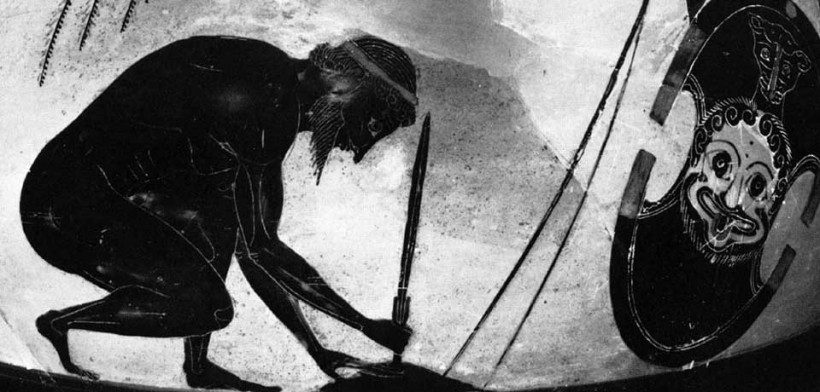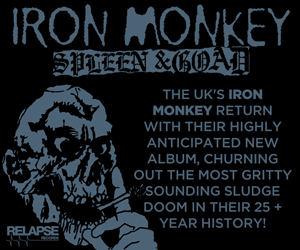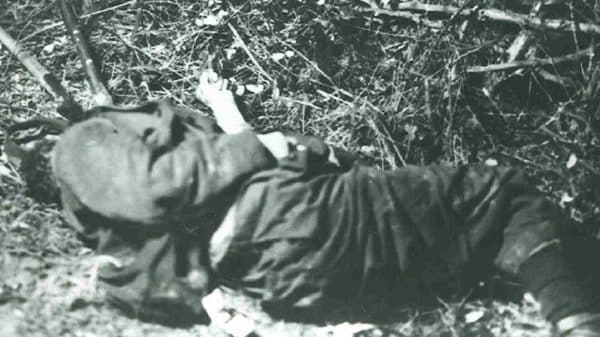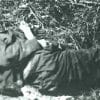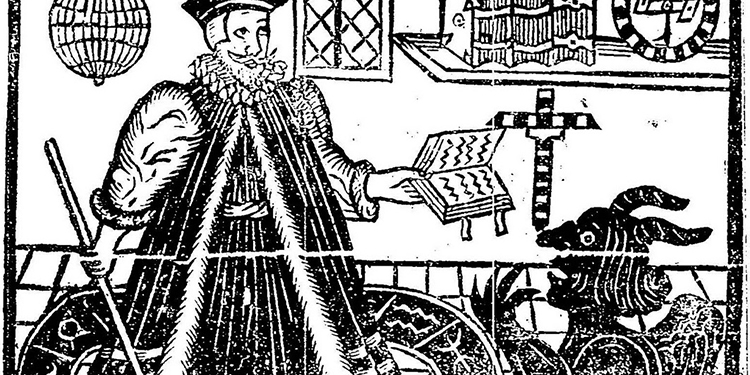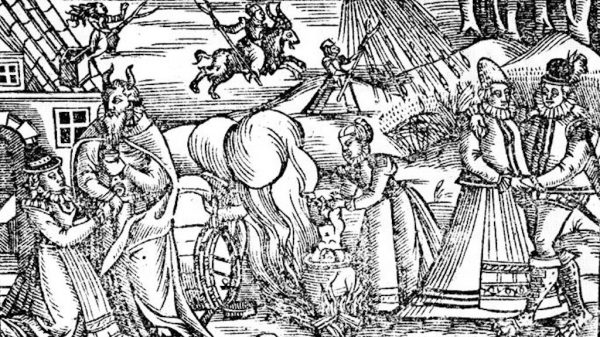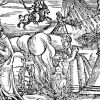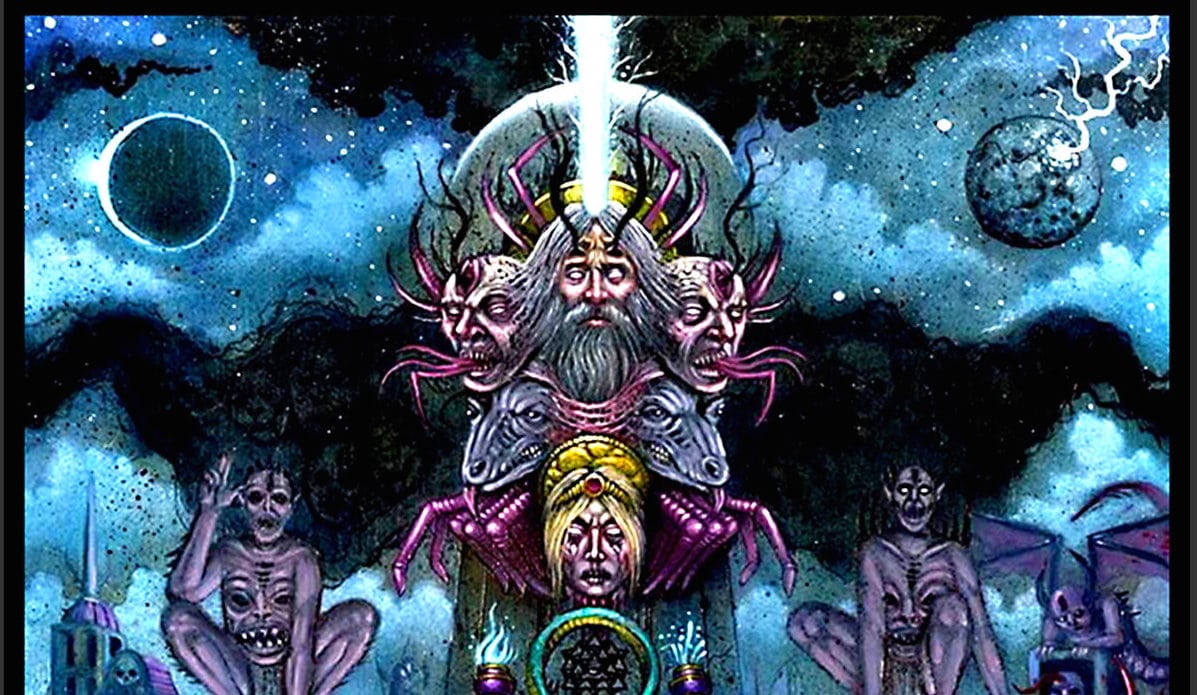Although suicide has always been considered to be the most personal of acts, it has a complex social and cultural history in the Western world – one that has been shaped by three-thousand years of shifting moralities, public opinions, popular superstitions, religious beliefs, medical interpretations and philosophical debates.
In ancient Greek and Roman societies, “self-death” was generally treated with a sense of ambivalence. Philosophers pondered the subject with an open mind, balancing notions of morality and free will, and ultimately believing it better to depart in peace rather than live a life of misery. Elite soldiers were expected to follow a hero’s code, where death by one’s own hand was embraced over surrender and battlefield disgrace. Medical practitioners routinely assisted in mercy killings, providing poisons to patients who wished to end prolonged sickness or suffering. Even members of the nobility, when faced with criminal charges and public shame, considered suicide to be dignified means for salvaging one’s personal legacy from total disgrace.
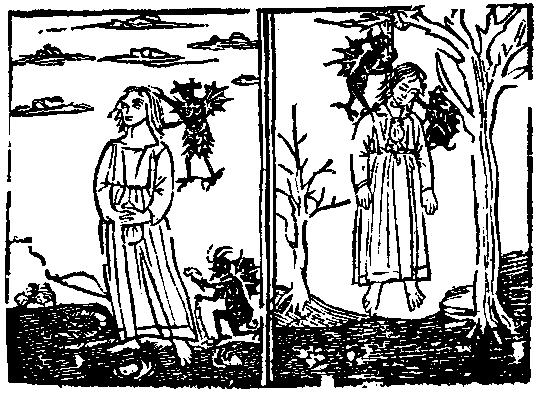 This relatively tolerant attitude would change dramatically with the rise of Christianity. The early Christian sects themselves gave little value to life in this world. Following the example of their executed messiah, they celebrated the acts of martyrs who embraced death rather than renounce their faith. But as the religion became institutionalized by the fifth-century this outlook would change. Suicide was unequivocally declared a moral abomination, a sinful act of violence against God directed by the Devil himself, “which shall not be forgiven… neither in this world, neither in the world to come.”1
This relatively tolerant attitude would change dramatically with the rise of Christianity. The early Christian sects themselves gave little value to life in this world. Following the example of their executed messiah, they celebrated the acts of martyrs who embraced death rather than renounce their faith. But as the religion became institutionalized by the fifth-century this outlook would change. Suicide was unequivocally declared a moral abomination, a sinful act of violence against God directed by the Devil himself, “which shall not be forgiven… neither in this world, neither in the world to come.”1
Initially the punishment was spiritual in nature; those who committed self-inflicted death would be posthumously excommunicated, their corpse denied a proper Christian burial (an ecclesiastical sentence that doomed the soul to an eternal state of purgatory, or worse). However, by the later medieval period, the suicidal act not only ran afoul of the church. Self-death, if proven to be committed with a sound mind, was declared “self-murder” under the common law, a felony crime subject to harsh punishments and grisly burial customs.2
Criminalized suicide, and the bizarre rituals associated with it, would become most pronounced in England during the Early Modern Era. Throughout this period it was customary for the corpse of a self-slayer to be dragged through the streets in mockery and defilement, staked through the heart, and then buried at a crossroads by the light of the moon – a practice that continued up until the 1820s.
“We are God’s possessions, and his servants, and should obey his commands like servants. Like prisoners, we should remain in our bonds. Like faithful followers, we should guard the treasure, and not reject the divine gift of life.”
– John of Wales, Communiloquium (1270)
As with most important theological questions during the Middle Ages, Saint Augustine was considered the leading Christian authority on the subject of suicide and the eternal damnation of souls. The suicidal act was condemned as a “detestable crime and a damnable outrage” by Augustine, who argued that “having given life, God alone had the power to determine when people were to leave this world.”3 By the sixth-century Church councils throughout Western Europe would adopt Augustine’s absolute position, refusing funeral rites and masses for those who committed self-inflicted death on themselves.
In England, the first church legislation concerning suicide was written by the Archbishop of York in 740, which instructed priests to deny proper Christian burial customs to those “who laid violent hands upon themselves” if they were proven to be of sound mind at the time of death.4 Writing a century later, Halitgar, the Bishop of Cambrai, declared that “if a man slay himself of his own will with a weapon or with any means the devil offers, it is not allowed that the Mass be sung for such a man, or that psalms be chanted when the corpse is committed to the earth, or that it should lie in an unpolluted tomb.”5 This position was reiterated in a canon attributed to King Edgar (the first ruler of a consolidated England) in the tenth century, who proclaimed it “neither lawful to celebrate mass for one who, by any diabolical instigation hath voluntarily committed murder on himself, nor to commit his body to the ground with hymns and psalmody or any rites of honorable sepulture.”6
Although Christian teaching by this time considered suicide to be a sin, it was a position that remained vague until the thirteenth century. Even in the Bible, where a half dozen suicides are mentioned, there is no explicit opposition to self-inflicted death.7
 Thomas Aquinas, the influential Dominican priest and philosopher, would be the first to advance a more comprehensive theological argument condemning the suicidal act. Setting the standard for religious condemnation, he argued that the sinful nature of suicide rested on three principles: divine ownership, harm against the social good and natural law.
Thomas Aquinas, the influential Dominican priest and philosopher, would be the first to advance a more comprehensive theological argument condemning the suicidal act. Setting the standard for religious condemnation, he argued that the sinful nature of suicide rested on three principles: divine ownership, harm against the social good and natural law.
“Whoever takes his own life,” according to Aquinas, “sins against God, even as he who kills another’s slave, sins against that slave’s master, and as he who usurps to himself judgment of a matter not entrusted to him. For it belongs to God alone to pronounce sentence of death and life.” In addition to undermining the divine order, the act was also considered a crime against society, “since every man is part of a community, what happens to him must affect the community, with the consequence that to kill oneself is to do injury to that community.” And lastly, the act of suicide violated natural law, as “everything naturally loves itself, the result being that everything naturally keeps itself in being, and resists corruptions so far as it can.”8
Throughout the Middle Ages, suicide was considered an act of religious transgression and subject to canon law and communal folk customs. However, following Norman conquest it also came to be considered a criminal offense – referred to as felonia de seipso, or in its shortened version, felo de se (Latin for “felon of himself”) – and under the jurisdiction of the Crown. Under feudal law, landless peasants were forced to swear allegiance to the king. Among other things, this oath bound them as the property of a lord who’s lands they were expected to work. As self-murder deprived the lord of a serf’s labor it was considered a form of theft from which compensation was required.9
In the thirteenth-century legal treatise De Legibus et Consuetudinibus Angliae (“On the Laws and Customs of England”), Henry de Bracton outlined the concept of felo de se, which was punished by the forfeiture of wealth (including unclaimed debts), tools and goods, livestock and family-held lands – thereby reducing surviving family members to a state of abject poverty. Although rarely enforced up to this point, a handful of individuals were successfully prosecuted for the crime of self-murder during this period and punished accordingly.10
“The Devil rangeth abroad like a roaring lion, seeking whom he may devour.”
– 1 Peter 5:8
The Devil was widely believed to be the guiding influence behind nearly every self-destructive act throughout the medieval and early modern periods. The Christian Church formally branded suicide as being ‘diabolically-inspired’ at the Council of Arles in 452.11 This belief would continue through the Middle Ages and reach its irrational apex following the Protestant Reformation – when “the Devil” ceased to be thought of in terms of metaphor or an afterlife concern, and began to be viewed as a real force in the world capable of manipulating the actions of humans and causing physical harm to those who fell under his influence.
Religious authorities initially treated suicide deaths with a sense of leniency, sympathetic to the plight of those who were unwittingly vexed by demonic forces and driven to desperate acts. Theodore of Tarsus, the seventh century Archbishop of Canterbury, exempted cases where the individual had acted out of fear or desperation, arguing that final judgment should “remain in the hands of God”. However, by the later medieval period, there was a growing insistence on the sinful nature of the act (“the gravest temptation the Devil inflicted on Christian souls”) and need for worldly punishment.12
Temptation has been a central concept associated with the Devil throughout Christian history. But it wasn’t until after Reformation that the role of tempter became the single most important aspect of his agency.13 This belief was exemplified in the teachings of the Puritans, who considered Satan to be a “largely unseen but […] constant and ubiquitous presence, the provoker of sinful thoughts, ever manipulating the flesh and minds of every Englishman and woman, pushing them to commit sin and crime and thereby capture their souls.”14 The Puritan minister John Sym wrote a lengthy tract on the subject of suicide in the 1630s (Lifes Preservative Against Self-Killing) in which he argued that the impulse towards taking one’s own life was the work of the Devil, “who himself is a murderer, and moves man to practice it.”15
The fact that suicide was considered a diabolical act is what set it apart from most other crimes (with the exception of witchcraft) from this period. The majority of unlawful acts could be blamed on worldly impulses such as greed, dishonesty or violence. Self-murder, on the other hand, was considered to be a crime with supernatural distinction, driven by Diabolo impellente (“the impulse of the Devil”) to undermine Christian values and moral order.16
Depression was believed to be the primary means used by the Devil to instigate suicidal thoughts among the spiritually weak. In fact, a diagnosis of melancholy would often be described during this period as balneum diaboli (“the devil’s bath”), a state from which Satan “compelled such crazed souls to think such damned thoughts against their wills, […] opposite to nature, opposite to God and his word.”17 From 1597 to 1634, an English physician named Richard Napier kept records of over a hundred people in his care who claimed to be tempted by the Devil to self-inflict harm or death on themselves.18
In a surviving transcript of a 1663 sermon concerning suicide and diabolical influence, the case of James Salowayes is highlighted. Imprisoned after failing to pay a gambling debt, Salowayes fell to despair and attempted to cut his own throat. He claimed that the disembodied voice of the Devil had spoken to him, declaring, “Thou shalt be burned in this prison, therefore it is better for thee to make away thy self than be burnt”.19 In a similar case, a London man named Anthony Joyce was unsuccessful in an attempt to take his own life in 1677. Questioned by authorities, he confessed that he had been “led by the Devil” into the act after he “forgot to serve God as he ought.”20
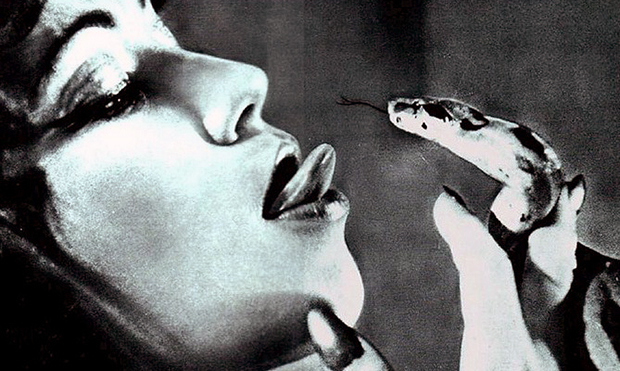 Similarly, Nehemiah Wallington, a young seventeenth-century Puritan, claimed in his diary to have made eleven attempts at ending his life under diabolic influence. The Devil “showed himself” in various manifestations, including a crow, his sister, a minister and a disembodied voice. “Satan tempted me,” recalls Wallington, “and I yielded to him and pulled out my knife and put it neere my throat. Then God of his goodness caused me to consider what would follow If I should do so. With that I felle out a weeping and I flong away the knife.”21 In 1684, a Baptist teacher named John Childs hung himself underneath the cellar stairs of his house. In a suicide note left behind he claimed to have been forsaken by God and influenced by “The Ministry of Darkness” to murder himself.22
Similarly, Nehemiah Wallington, a young seventeenth-century Puritan, claimed in his diary to have made eleven attempts at ending his life under diabolic influence. The Devil “showed himself” in various manifestations, including a crow, his sister, a minister and a disembodied voice. “Satan tempted me,” recalls Wallington, “and I yielded to him and pulled out my knife and put it neere my throat. Then God of his goodness caused me to consider what would follow If I should do so. With that I felle out a weeping and I flong away the knife.”21 In 1684, a Baptist teacher named John Childs hung himself underneath the cellar stairs of his house. In a suicide note left behind he claimed to have been forsaken by God and influenced by “The Ministry of Darkness” to murder himself.22
As the Devil’s servants in the community, witches would also be accused of introducing suicidal thoughts into vulnerable minds. Agnes Buttress, a young woman treated by the above-mentioned Richard Napier in 1618, blamed her attempted suicide of a witch’s “bad tongue”. In 1620, Christopher Monke, of Leicestershire, told authorities that a local minister had bewitched his wife and son, causing the boy to cut his own throat. A Somerset man named Richard Bovet reported a local teenager who had been influenced by a suspected witch into repeated suicide attempts in 1684.23 And in 1712, Jane Wenham, the last woman to be convicted of witchcraft in England, was accused of influencing two young girls to try and drown themselves.24
Throughout the Early Modern era, the public’s fear of suicide and diabolic intervention could also be found in written culture, “in tracts, sermons, devotional and conduct literature, plays and ballads, as well as in diaries and common-place books.”25 One seventeenth century almanac would annually report on the suicides of otherwise unknown individuals. The purpose, according the publisher, was to warn readers “against the evil suggestions of the Prince of Darkness, that implacable Enemy of Mankind.”26
“…when the ghost of body issues forth from the grave and finds that there are four paths stretching in as many directions he will be puzzled to know which way to take and will stand debating until dawn compels him to return to the earth, but woe betide the unhappy being who happens to pass by when he is lingering there perplexed and confused.”
– Montague Summer, English clergyman (1928)
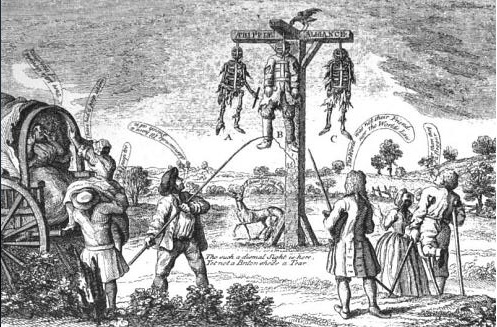 The crime of self-inflicted death would be tried posthumously by a coroner’s jury. If found guilty of “self-murder” one would be punished according to both common and canon law. The Crown would confiscate the self-murderer’s worldly possessions as restitution; religious authorities would deny the requisites for a heavenly afterlife (prayers, funerary services and a Christian burial). But punishment didn’t end there. It was also customary – particularly during the Tudor and Stuart periods – for the corpse of a felo de se suicide to undergo a form of ritual desecration: defilement of one’s body and living memory, followed by “profane burial” at a crossroads.
The crime of self-inflicted death would be tried posthumously by a coroner’s jury. If found guilty of “self-murder” one would be punished according to both common and canon law. The Crown would confiscate the self-murderer’s worldly possessions as restitution; religious authorities would deny the requisites for a heavenly afterlife (prayers, funerary services and a Christian burial). But punishment didn’t end there. It was also customary – particularly during the Tudor and Stuart periods – for the corpse of a felo de se suicide to undergo a form of ritual desecration: defilement of one’s body and living memory, followed by “profane burial” at a crossroads.
The significance of a crossroads burial has a unique history of its own, one that traces back to pagan times. Crossroads have long been considered an uneasy place, transitional gaps between bounded areas that were unclaimed and vulnerable to supernatural forces. The people of antiquity would leave “polluted materials” expelled from society – be it household garbage or executed criminals – at these converging pathways. In ancient Greece, the customary treatment of those convicted of parricide (murder of a blood relative) was execution, followed by ritual desecration at a crossroads. The body would be “carried, naked, to an appointed crossroads lying outside the city” and “each official [would] throw a stone at the corpse’s head” as an act of purification. The body was then left unburied.27
Among the Germanic people, criminals would be ritually executed and left hanging from gallows located at highway crossings as a blood offering to the gods. The early Christians continued to associate crossroads with these heathen practices, and considered them to be spoiled and haunted grounds. Like the ancient Greeks, Romans and Germanics before them, highway crossings were customarily designated as areas where the corpses of criminals who were guilty of particularly heinous acts should be discarded.28 They were also believed to be the meeting place of witches, who used these liminal points as a portal to commune with malevolent forces from the supernatural realm.
Since crossroads were considered dissociated places, they provided symbolically suitable grave sites for the outcasted – and potentially restless – dead. As an act of suicide cut a life prematurely short it was thought of as having broken from the divine order, and as a result, the soul was condemned to a state of eternal purgatory. The ghosts of suicide deaths were believed to be particularly hostile and susceptible to demonic control. According to some folklorists and historians, the significance of burying the body at a crossroads was to confuse the restless spirit left behind so they could not easily return to the community from which they took up residence in life.29
In Germany, there is a medieval reference to suicide and crossroads burial in the 13th century Landrecht laws of Silesia, which states that “when someone kills himself in a house or field he shall be buried at a road junction.” This custom was further defined by the Rügen laws of 1530, which suggested that the body be dragged to the nearest crossroads, “where two or three field boundaries are marked, and there bury it in the ground and soil of the lordship in which he killed himself, putting his head where Christian dead have their feet.”30
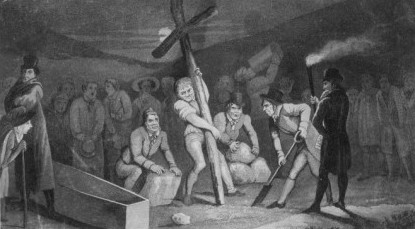 Archeological evidence from England points to various outcast burial customs, including crossroads burials, going back to Anglo-Saxon times. The first documented instance of this practice being used specifically for a suicide death dates to 1510, when Robert Browner, the superior of Butley Priory in Suffolk, hung himself after mismanaging church finances and his corpse was ordered staked and buried at a highway crossing.31 In the decades that followed, Protestant reformers attempted to rid the church of archaic rituals that embodied medieval Catholic or pagan elements. But when it came to burial practices – particularly in the case of suicides and other postmortem outcasts – the folk customs of the past continued to be followed.
Archeological evidence from England points to various outcast burial customs, including crossroads burials, going back to Anglo-Saxon times. The first documented instance of this practice being used specifically for a suicide death dates to 1510, when Robert Browner, the superior of Butley Priory in Suffolk, hung himself after mismanaging church finances and his corpse was ordered staked and buried at a highway crossing.31 In the decades that followed, Protestant reformers attempted to rid the church of archaic rituals that embodied medieval Catholic or pagan elements. But when it came to burial practices – particularly in the case of suicides and other postmortem outcasts – the folk customs of the past continued to be followed.
Incorporating both inverted Christian and pagan rituals, the Rites of Desecration was a burial custom used to symbolically cast out suicides from the Christian community (both living and dead) in England during this period.32
The corpse of a suicide death was considered “polluted” and unworthy of proper Christian funerary and burial customs. Instead, it was to be interred at night, placed naked and face down in unhallowed ground (most often at a crossroads, or some other unclaimed stretch along a highway). It was important that the body be buried facing north to south, as opposed to the Christian custom of west to east. It would then be staked to the ground, generally through the heart, as a means to anchor the spirit to the grave (or else prevent the body from rising to face God at the final day of judgment). In some instances, this would be accompanied by postmortem decapitation, with the head placed between the legs. The ritual was completed by piling stones on top of the desecrated corpse.33
Beyond religious purpose, this strange custom also served as a deterrent for others contemplating self-murder. John Weever, a seventeenth century English antiquarian, explained that the purpose of burying corpses of suicidals at public crossings “with a stake thrust through their bodies, [was] to terrifie all passengers, by that so infamous and reproachfull a buriall, [so as to] not to make such their finall passage out of this world.”34
The remains of other “unclean” deaths – suspected witches, murderers, thieves, gypsies and traitors – could be treated in the same manner. A version of this grim practice is described in a 1657 coroner’s report for Miles Sindercombe, a rebel leader who was publicly executed for his part in a conspiracy to assassinate Oliver Cromwell. Inverting the Christian practice of respectfully carrying the body aloft, Sindercombe’s naked corpse was dragged from the gallows ‘head forward’ behind a horse to his roadside grave. A long stake was then driven through the body and into the earth, with the “part of the Stake [that] remained above ground plated with Iron, which may stand as an example of terror to all Traytors for time to come.”35
“O death destroye my memorie which is my Tormentor; my thoughts and my life cannot dwell in one body.”
– Sir Walter Raleigh, in a letter sent to his wife prior to attempted suicide
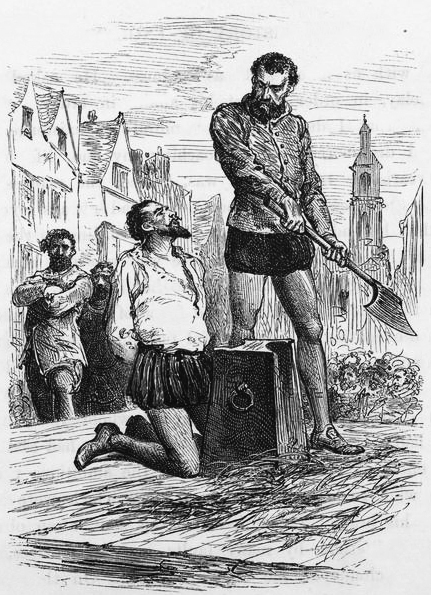 The English Reformation touched off a series of social, political and religious changes throughout the country. Having broken with papal authority in 1534, the Church of England came under monarchist rule. This was followed by a series of new legal structures that extended the administrative control of the church and state into the countryside far more pervasively than ever before. Simultaneously, the animosity between Protestants and Catholics, and inter-Protestant factionalism between Anglicans and Puritans, led to a period of doctrinal insecurity and persecution. It wouldn’t be long before sacred truths came under assault, old superstitions were given new life, and spiritual enemies were found at every turn.
The English Reformation touched off a series of social, political and religious changes throughout the country. Having broken with papal authority in 1534, the Church of England came under monarchist rule. This was followed by a series of new legal structures that extended the administrative control of the church and state into the countryside far more pervasively than ever before. Simultaneously, the animosity between Protestants and Catholics, and inter-Protestant factionalism between Anglicans and Puritans, led to a period of doctrinal insecurity and persecution. It wouldn’t be long before sacred truths came under assault, old superstitions were given new life, and spiritual enemies were found at every turn.
It was during this era that public condemnation of suicide became even more pronounced, and the role of the Devil more conspicuous. Underscoring the Church of England’s stance for the next century, George Abbot, the seventeenth century Archbishop of Canterbury, declared the taking of one’s own life to be “a sin so grieuous that scant any is more hainous unto the Lord.”36 Penalties also increased in severity, and were rigorously enforced. Between 1485 and 1660 over 95% of those who killed themselves were convicted of felo de se (with only 2% excused as non compos mentis – “not of sound mind”) and punished accordingly.37
The custom of ritual desecration also continued unabated. A typical example from this period can be found in the 1595 case of Elizabeth Wickham, a widowed woman parishioner from St. Botolph’s Algate, “who hanged herself upon a garden pale by her apron strings”. Upon discovering she had previously attempted to take her own life, a verdict of felo de se was passed. She was buried “in the alley where she hanged herself, […] having a stake through her in remembrance of her wickedness.”38 Another example comes from a 1665 coroner’s report, documenting the the treatment of the suicide of a young Wiltshire man named Henry Apes. After hanging himself in a barn, Apes’ body was ordered “buryed between the two parishes of Staunton and Alton Barnes, with two stakes thrust through him.”39
In the wake of the English Civil Wars of 1642-51 and the Revolution of 1688, and with the growing influence of Enlightenment philosophies, the country underwent further social and systematic changes. Royalist authority was challenged, the Church of England’s theocratic monopoly was broken, radical and ultra-traditionalist religious sects were increasingly marginalized, and, among other legal reforms, the laws concerning self-murder were being tempered. The ‘age of reason’ had given rise to religious moderation, humanitarian perspectives and scientific rationalism – all of which contributed to a marked shift in public opinion around the subject of suicide.
During the reign of Charles III, this trend towards secularization was reflected in the rulings of coroner’s juries and selective enforcement of suicide laws. In fact, by the last three decades of the eighteenth century, felo de se verdicts became as rare as non compos mentis ones had been during the Tudor period. Over 97% of the recorded suicides of this period were declared mentally unstable, with the rare instances of a felo de se verdict reserved for violent criminals or other persons of ill-repute as a means of posthumous punishment and disgrace.40
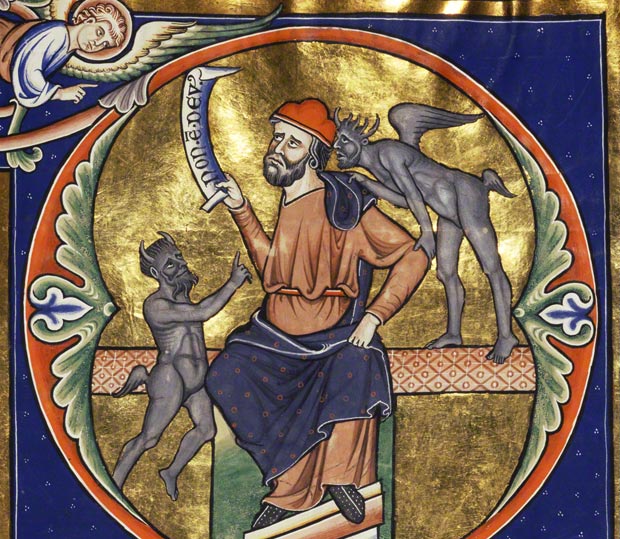 There were, however, still evangelical sects (Methodists, Nonconformists) who clung to the archaic beliefs of the past that considered the Devil to be a co-conspirator involved with every act of self-murder – a belief shared by many common folk, regardless of denomination. And for those who were convicted of self-murder, punishment remained as severe (and the burial practices as grisly) as ever.
There were, however, still evangelical sects (Methodists, Nonconformists) who clung to the archaic beliefs of the past that considered the Devil to be a co-conspirator involved with every act of self-murder – a belief shared by many common folk, regardless of denomination. And for those who were convicted of self-murder, punishment remained as severe (and the burial practices as grisly) as ever.
In 1722, a London bank robber who ended his life by a pistol shot to the head was convicted posthumously, “wrapp’d in an old Blanket, and buried upon Blackheath, with a Stake drove through him”. A Shropshire shoemaker who hung himself and was declared fel de se in 1731. His family buried the corpse clandestinely in his back garden, hoping to avoid public shame. However public officials dug him up and relocated the corpse to a public highway, re-interring him following the traditional custom.41 A woman accused of poisoning sixteen people at a workhouse in Epworth and then ingesting arsenic to end her life was found guilty of self-murder by a coroner’s jury in 1790. Her body was buried along a highway with two stakes driven through the corpse. And a few years later, in 1793, a thief named Jones had robbed a bank’s clerk and hung himself in his jail cell to avoid trial. His body was paraded through the streets on an open cart with a white cloth covering his face, and deposited in a pit with a stake driven through it.42
One of the most infamously documented profane burials took place in December 1811, when John Williams committed suicide after he was accused of being “The London Monster” (a notorious highwayman and serial killer). Williams’ corpse was drawn through the street on a cart with his murder weapons – a bloodied maul and chisel – by his side, followed by a massive procession of up to a thousand people. When they reached the junction of Cannon Street and Cable Street, “the body was crammed into the ground, and a stake driven through the heart with the same maul Williams used to kill his victims” (his staked remains were discovered by a gas company digging in the area in 1866).43
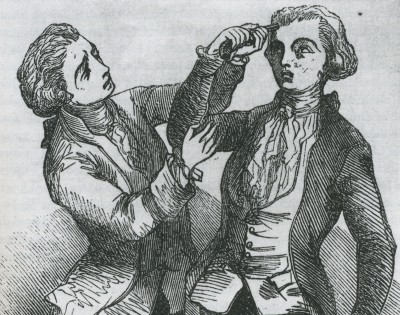 The Rites of Desecration continued to be performed for exceptional criminal suicides into the 1820s. The last known documented instance of this practice took place in June 1823 when Abel Griffiths, a 22-year old law student who took his own life after murdering his father, received a profane burial at the crossroads where London’s Victoria Station now stands. Reflecting the shift in public opinion, the Annual Register criticized the macabre spectacle, noting that “the disgusting part of the ceremony of throwing lime over the body and driving a stake through it was dispensed” prior to interment.44 The old burial custom – described at this time by moralists and parliamentarians as “an odious and disgusting ceremony” and “an act of malignant and brutal folly,”45 – would be suppressed by the 1823 ‘Burial of Suicide Act’.
The Rites of Desecration continued to be performed for exceptional criminal suicides into the 1820s. The last known documented instance of this practice took place in June 1823 when Abel Griffiths, a 22-year old law student who took his own life after murdering his father, received a profane burial at the crossroads where London’s Victoria Station now stands. Reflecting the shift in public opinion, the Annual Register criticized the macabre spectacle, noting that “the disgusting part of the ceremony of throwing lime over the body and driving a stake through it was dispensed” prior to interment.44 The old burial custom – described at this time by moralists and parliamentarians as “an odious and disgusting ceremony” and “an act of malignant and brutal folly,”45 – would be suppressed by the 1823 ‘Burial of Suicide Act’.
However, suicidal deaths still carried a heavy stigma and continued to be punished and outcasted post-death (placed on the north side of churchyards, alongside unbaptized infants, excommunicates and executed criminals).46 The penalty of property forfeiture wouldn’t be repealed until 1870, and religious penalties continued on for another decade.47 “Self-murder” itself would remain a criminal act on the statute books right up until the passage of ‘The Suicide Act’ of 1961.
Although suicide has since been secularized, decriminalized and largely demystified in the public mind, there still remains a folkloric belief centered around England’s old crossroads – and the restless ghosts who are said to reside there. Emotionally tortured in life, defiled in death and disgraced in memory, the “self-murderers” of the past will continue to haunt the popular mind, reminding us of the archaic beliefs and macabre rituals of the not-so-distant past.
Mark Laskey
http://illuminating-shadows.blogspot.com
——
FOOTNOTES
1. Alexander Murray, Suicide in the Middle Ages: The Curse of Self Murder, Volume II (Oxford: Oxford University Press, 2011), 190.
2. Michael MacDonald & Terence Murphy, Sleepless Souls: Suicide in Early Modern England (Oxford: Oxford University Press, 1994), 15.
3. Augustine of Hippo, Augustine: The City of God Against the Pagans, Books 1-13 (Cambridge: Cambridge University Press, 1998), 38.
4. Bertram S. Puckle, Funeral Customs: Their Origin and Development (London: T.W. Laurie, Ltd, 1926), chapter VII.
5. Murray, 265.
6. MacDonald & Murphy, 19.
7. Jeffrey Watt, From Sin to Insanity: Suicide in Early Modern Europe (Ithaca: Cornell University Press, 2004), 10.
8. Thomas Aquinas, Summa Theologica (New York: Library of Alexandria, 2012), Fifth Article [II-II, Q. 64, Art. 5].
9. Murray, 83-84.
10. MacDonald & Murphy, 22.
11. Robert Garland, The Greek Way of Death (Ithaca: Cornell University Press, 2001), 96.
12. MacDonald & Murphy, 20.
13. Nathan Johnstone, “The Protestant Devil: The Experience of Temptation in Early Modern England,” Journal of British Studies (2004), 176.
14. Owen Davies, Talk of the Devil: Crime and Satanic Inspiration in Eighteenth-Century England (Hertfordshire: University of Hertfordshire, 2007), 4.
15. John Sym, Lifes Preservative Against Self-Killing (New York: Routledge, 2015), 246.
16. Murray, 191.
17. Robert Burton, Anatomy of Melancholy, Volume 3 (Charleston: Nabu Press, 2010), 478.
18. MacDonald & Murphy, 51.
19. R.F., The true relation of the bloody attempt by James Salowayes to cut his own throat in the compter, upon Sunday the 21 of June, 1663 (London: Printed by R. Dickinson, 1663).
20. MacDonald & Murphy, 52.
21. Mark Williams, Suicide and Attempted Suicide: Understanding the Cry of Pain (Collingdale, PA: Diane Publishing, 2001), 6.
22. Josephine Seto, “Inventing the Devil and Experiencing Emotion in Seventeenth Century England,” 9. http://hdl.handle.net/2123/8730.
23. MacDonald & Murphy, 53.
24. Cecil Ewen, Witchcraft and Demonianism (New York: Barnes & Nobel, 1933), 112.
25. Johnstone, 175.
26. MacDonald & Murphy, 304.
27. S.I. Johnson, “Crossroads,” Zeitschrift für Papyrologie und Epigraphik, vol. 88 (1991): 222.
28. Puckle, Chapter VIII.
29. MacDonald & Murphy. 47.
30. Murray, 46-47.
31. Robert Halliday, “Criminal Graves and Rural Crossroads,” British Archeology, no. 25, June 1997.
32. MacDonald & Murphy, 18.
33. Murray, 46-47.
34. John Weever, Ancient Funerall Monuments (London: Printed by Thomas Harper, 1631), 22.
35. The Whole Business of Sindercome (London: Printed by Tho. Newcomb, 1657), 16.
36. MacDonald & Murphy, 31.
37. MacDonald & Murphy, 16.
38. Watt, 26.
39. Andrew Reynolds, Anglo-Saxon Deviant Burial Customs (Oxford: Oxford University Press, 2009), 217.
40. MacDonald & Murphy, 133.
41. MacDonald & Murphy, 213.
42. MacDonald & Murphy, 137-38.
43. Catherine Arnold, Necropolis: London and It’s Dead (London: Simon & Schuster, 2007), 187.
44. Barbara Gates, Victorian Suicide: Mad Crimes and Sad Histories (Princeton, NJ: Princeton University Press, 1988), 6.
45. MacDonald & Murphy, 348-49.
46. Williams, 15.
47. Arnold, 187.


